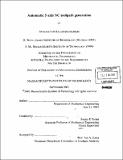Automatic 5-axis NC toolpath generation
Author(s)
Balasubramaniam, Mahadevan, 1976-
DownloadFull printable version (18.38Mb)
Alternative title
Automatic five-axis NC toolpath generation
Other Contributors
Massachusetts Institute of Technology. Dept. of Mechanical Engineering.
Advisor
Sanjay E. Sarma.
Terms of use
Metadata
Show full item recordAbstract
Despite over a decade of research, automatic toolpath generation has remained an elusive goal for 5-axis NC machining. This thesis describes the theoretical and practical issues associated with generating collision free five-axis roughing and finishing toolpaths automatically from the CAD model of the part. Instead of decomposing the shape into manufacturing primitives we generate the collision free tool paths directly from the shape of the workpiece by using accessibility arguments. Specific points of discussion in this thesis include: * A scheme for generating five-axis tool paths using "accessibility" as the driving constraint for tool path generation. * A scheme for approximating the "accessibility" of a class of tools with visibility because direct evaluation of accessibility information of a tool in a part has been shown to be computationally expensive by several researchers. Visibility of a point along an orientation is a necessary condition for accessibility. We have developed algorithms to compute the visibility information rapidly using graphics hardware. * A scheme for extracting the most "promising" orientation from the visibility information for the tool in a "global" sense. Algorithms to process the visibility information to select the orientation based on the characteristics of the machining process have been developed. (cont.) * A scheme for computing a valid collision free orientation by performing a local search in the neighborhood of the "promising" visible direction using rapid collision avoidance algorithms. Visibility is a necessary but not a sufficient condition for accessibility because visibility cannot account for the geometry of the tool. * A scheme for determining a smooth interpolation between valid tool postures at the end points. This is not a trivial task because the tool must not interfere with the part while interpolating between valid postures. The visibility cones of the end points are used to compute a "globally" valid interpolatory path and the interpolated postures are then "locally" profiled for access by using rapid collision detection algorithms. The algorithms outlined in this thesis make it possible, for the first time, to generate 5-axis CNC tool paths automatically from a CAD file. The algorithms have been implemented and tested on several parts.
Description
Thesis (Ph. D.)--Massachusetts Institute of Technology, Dept. of Mechanical Engineering, 2001. Includes bibliographical references (leaves 96-101).
Date issued
2001Department
Massachusetts Institute of Technology. Department of Mechanical EngineeringPublisher
Massachusetts Institute of Technology
Keywords
Mechanical Engineering.